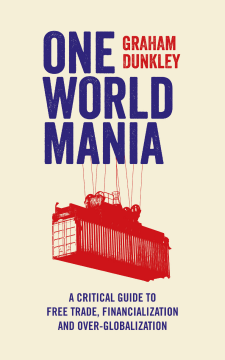
Additional Information
Book Details
Abstract
In this much-needed book, Graham Dunkley challenges the oft-repeated notion that free trade and global integration are the best means of development for all nations at all times – an idea that has proved even more misguided in the wake of the global financial crisis. By contrast, Dunkley reveals – through a wide range of statistical analysis and case studies – that at best the evidence is mixed. Looking systematically at issues such as trade-led growth, supply chains and financialization, One World Mania reveals the many problems that over-globalization has caused, often at great human cost.
An indispensible guide for anyone wishing to understand the shortcomings of current global economic policies.
‘A scholarly debunking of the vastly overrated benefits of free trade and globalization. Dunkley shows that mainstream economic theory has sold the world yet another dud.’
Steve Keen, author of Debunking Economics
‘Provides a beautifully written, evidence-based argument that the economic benefits of globalization have been exaggerated.’
Robert H. Wade, London School of Economics
'Capitalist globalisation needs a supporting ideology … Challenging that ideology by scrutinising the actual effects of globalisation is fundamentally important. Graham Dunkley’s contribution is the latest in a long line of books seeking to do so, and it is one of the very best. … This is a powerful critique of capitalist globalisation, its ideology of free trade and "globalisation pacts".'
Frank Stilwell, Australian Political Economy
Dr Graham Dunkley has variously been a freelance journalist, worked with NGOs and been an economics lecturer at Victoria University, Melbourne. He is currently an independent writer. He is the author of The Free Trade Adventure and Free Trade: Myth, Reality and Alternatives (both published by Zed Books).
Table of Contents
| Section Title | Page | Action | Price |
|---|---|---|---|
| Front cover | Front cover | ||
| About the author | i | ||
| Title page | iii | ||
| Copyright | iv | ||
| Dedication | v | ||
| Contents | vii | ||
| Figures and tables | viii | ||
| Acknowledgements | ix | ||
| Abbreviations and acronyms | x | ||
| Introduction | 1 | ||
| 1. Complexity, mythology and over-globalisation: an overview of global integration | 8 | ||
| Internationalisation versus globalisation | 10 | ||
| Some history and mythology of globalisation | 12 | ||
| Conclusion | 17 | ||
| 2. The perennial debate: free trade and globalisation in theory and history | 19 | ||
| The magic of numbers and triangles | 19 | ||
| The story gets complicated | 23 | ||
| Mainstream rebels | 28 | ||
| Vindicated by history? | 33 | ||
| Conclusion | 37 | ||
| 3. The biggest game on earth: the myth of trade-led growth | 38 | ||
| The great debate | 39 | ||
| It’s complicated! | 41 | ||
| Lies, damned lies and computer models | 50 | ||
| What’s in a number? | 62 | ||
| Conclusion | 66 | ||
| 4. Converting the world to capitalism: the rise and fall of the Washington Consensus | 68 | ||
| The making of an elite consensus | 70 | ||
| The Middle East and North Africa (MENA) | 73 | ||
| Sub-Saharan Africa (SSA) | 75 | ||
| Latin America | 81 | ||
| South Asia (Indian sub-continent) | 89 | ||
| East and Southeast Asia | 92 | ||
| China | 101 | ||
| Conclusion | 107 | ||
| 5. A planet in chains: capital, supply chains and the economy of nowhere | 110 | ||
| But how does it work in theory? | 113 | ||
| Juggernauts of the chained world | 115 | ||
| Juggernauts in action | 118 | ||
| Finding their own chains | 121 | ||
| The myth of TNC/FDI/GVC-led growth | 124 | ||
| Runaway value chains | 132 | ||
| The rise of nowhere | 142 | ||
| Conclusion | 150 | ||
| 6. The dark lords of money: financial globalisation, crises and insanity | 152 | ||
| The root of (some) evil | 154 | ||
| The necessity of virtue | 156 | ||
| Crises, crashes and catastrophes | 158 | ||
| Everybody loves finance | 164 | ||
| The myth of finance-led growth | 171 | ||
| The financial system from hell | 175 | ||
| A catastrophe unforetold? | 184 | ||
| Conclusion | 195 | ||
| 7. Globalisation and people: the many costs of global integration | 196 | ||
| Adjusting the workers | 197 | ||
| Race to the top or bottom? | 201 | ||
| Poverty and the myth of global solutions | 206 | ||
| The rise and rise of inequality | 211 | ||
| The myth of migration-led growth | 216 | ||
| Trading the green? | 219 | ||
| The globalisation of everything? | 224 | ||
| Conclusion | 240 | ||
| 8. One world mania: the problems of excessive global integration | 242 | ||
| The myth of globalisation-led growth | 243 | ||
| The war between integration and autonomy | 249 | ||
| Wall-to-wall trade agreements | 258 | ||
| The limits of integration and globalisation | 273 | ||
| An alternative world order | 278 | ||
| Conclusion | 286 | ||
| Conclusion | 288 | ||
| Appendix | 298 | ||
| Notes | 302 | ||
| Bibliography | 309 | ||
| Index | 336 | ||
| Back cover | Back cover |
